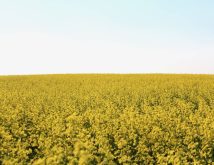SOUTHWEST REGION
The region received 20 to 50 mm of rainfall over the past week. An area around Miniota and Brandon reported severe crop damage by hail, along with some property damage.
Early-seeded cereal crops are starting to turn and the late-seeded crops are in the heavy dough stage. Harvest of winter wheat and fall rye has started with reports of average-to below-average yields. Most winter wheat has been desiccated and some fall rye has been swathed. Canola is approximately three weeks away from swathing. Producers have started to harvest peas. Warmer weather would benefit crop growth.
Read Also

Manitoba boosts stake in cereals centre to $23.5 million
Premier Wab Kinew said the additional project funds will help ‘Trump-proof’ the provincial economy.
Second-cut hay has started with reports of average yields. Rain over the past week will affect quality. Pastures have benefited from the rain; however, warm weather would help regrowth.
Grasshoppers have been the major insect problem.
NORTHWEST REGION
Significant rain fell during the week with 25 mm at The Pas, 100 mm at Swan River, 56 mm at Roblin, 63 mm at Dauphin and 38 to 49 mm in Ste. Rose.
The majority of the cereal crops are in the dough stage. Canola crops have finished flowering and some early-seeded canola around Ste. Rose may be swathed later in the week if weather conditions permit. Canada thistle and second flushes of wild oats are present in cereals and flax crops particularly in the Swan River Valley.
First-cut haying is nearly complete. Recent heavy rains will inhibit any wild hay harvest. Recent rainfall has improved pasture conditions but heat is needed now.
CENTRAL REGION
Hot weather accelerated crop development and maturity. Rainfall accumulations varied from 10 to 88 mm. Hail ranging from pea size to 75 mm in diameter damaged crops and property in the La Salle to Brunkild area.
Fungicide applications continue in edible bean fields for white mould control.
Winter wheat harvest has started with reports of yields ranging from 30 to 90 bu./acre. Barley and perennial forage crops are being swathed.
Early-seeded spring wheat may be sprayed with preharvest glyphosate this week. Canola is maturing with late-seeded canola still blooming. Corn is in the grain-fill stage with the exception of later-maturing hybrids or late-planted corn. Sunflowers are blooming.
Aphids are noticeable on cereal grains but control measures are likely not required. Soybean aphids are in low numbers in most fields and continue to be monitored.
Dairy-quality second-cut alfalfa has been taken off with good yields. Lack of warm weather is slowing regrowth. Wet weather is keeping pastures green and growth adequate.
EASTERN REGION
Warm, sunny weather at the beginning of last week turned into showers which resulted in rainfall accumulations of five to 67 mm. There were reports of hail on numerous days last week but overall damage appears to be minor. Heat accumulation across the region continues to be below normal for the cropping season.
Crop development throughout the region remains variable. Winter wheat harvest began in the region last week with yields in the 80-to 90-bu./ac. range. Most of the barley is at the hard dough stage with swathing commencing this week if weather conditions allow. Most of the spring wheat and oats is in the soft dough stage. Swathing of early-seeded canola fields will commence this week. Lateseeded canola crops are finished flowering and continue to pod fill. Soybeans are in the R3 to R4 stage. Soybean aphids below economic threshold levels are reported throughout the region. Flax is pod filling. Corn is silking in most fields. Sunflowers are at the R5.1-R5.5 stage. Downy mildew, sclerotinia stem rot and rust have been reported in sunflowers. In the case of rust, producers are monitoring its progress to determine if fungicides will be necessary.
Hayfield conditions are rated as fair to good with pasture land conditions rated as good. Second cut moved into full swing with some downed acres receiving rain, which will impact quality.
INTERLAKE REGION
Warm temperatures at the start of the week turned into scattered showers that began early Thursday morning and continued through the weekend. Rainfall amounts ranged from 12 mm at Moosehorn to 50 mm in the Arborg/Riverton areas.
Winter wheat harvest has started in the South Interlake. Initial samples are showing very good quality, but the recent rains may cause quality issues. Swathing of fall rye should start in the coming week. Barley crops are approaching harvest in the southern areas of the region. Feed grains in the north Interlake are heading. Lateseeded green feed crops need warm, dry conditions.
Canola development ranges from full bloom to complete podding. Sclerotinia stem rot is being reported as a result of weather conditions favouring disease development. Corn is showing tassels.
Timothy and perennial rye grass swathing will start this week. Some meadow fescue has been harvested in the south yielding 300 lbs./ac.
The recent rainfall will restrict further progress on haying. Hay and straw supplies remain a concern with producers.














